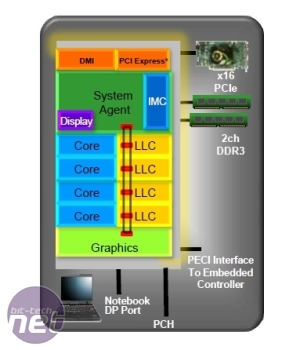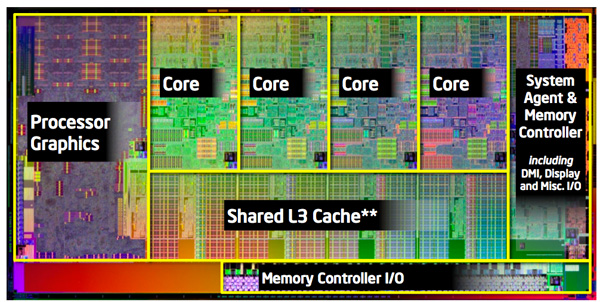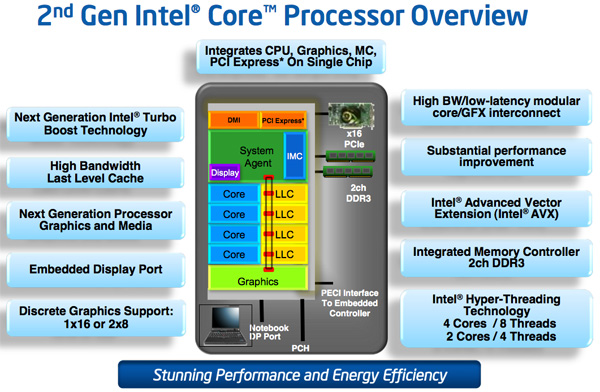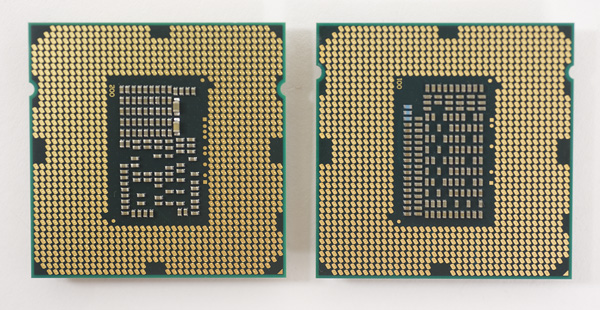The reason for choose VGA is
- the specification
- how much it's cost
- your needs for choose that VGA
There are some type for Nvdia if you want to know more about the information :
- Code for every Product
If you know Nvdia divided in 3 code. There are Series
- GTX xxx
- GTS and GT xxx
- GeForce
For every series have speciality in Series GTX we know that are High End Video Graphic for example GTX 590. If you want best quality in Nvdia buy the GTX series. But you will know more quality, more price too. In GTX Series $1.200 ~ $ 6.000.
In Series GTS/GT that are Mid End Video Graphic for example GTS 450. If you want middle quality in Nvdia buy the GTS/GT series. But in this series you must compare for every advantage in your needs because There are some Graphic Card at High cost but quality isn't good enough. In GTX Series $ 300 ~ $ 1.300.
If you have troble in money and you want more quality for some graphic card, Nvdia prepare for that. The Series is GeForce like GeForce/GeForce GS. In this Series the price is above $ 300
All About New Computer Generations
Blogger news
Saturday, July 9, 2011
Tuesday, June 7, 2011
Kindle, Wi-Fi, Graphite, 6" Display with New E Ink Pearl Technology
Kindle is amazon #1 bestselling item for two years running. It’s also the most-wished-for, most-gifted, and has the most 5-star reviews of any product on Amazon. Now it's even better.
See How the Latest Kindle Compares to the Previous Generation
- All-New, High-Contrast E Ink Screen – 50% better contrast with latest E Ink Pearl technology
- Read in Bright Sunlight – No glare
- New and Improved Fonts – New crisper, darker fonts
- New Sleek Design – 21% smaller body while keeping the same 6" size reading area
- 17% Lighter – Only 8.5 ounces, weighs less than a paperback
- Battery Life of Up to Two Months – A single charge lasts up to two months with wireless off
- Double the Storage – Up to 3,500 books
- Built-In Wi-Fi – Shop and download books in less than 60 seconds
- 20% Faster Page Turns – Seamless reading
- Enhanced PDF Reader – With dictionary lookup, notes, and highlights
- WebKit-Based Browser – Browse the web over Wi-Fi (experimental)
Kindle at a Glance
| |
Kindle Comparison
| Kindle Wi-Fi | |||
![Kindle, Wi-Fi, Graphite, 6" Display with New E Ink Pearl Technology [Includes USB Cable for Charging. For International Shipment]](http://g-ecx.images-amazon.com/images/G/01/kindle/shasta/photos/kindle-drk-trans-comparison._V188700473_.png) | ![Kindle 3G, Free 3G + Wi-Fi, 3G Works Globally, Graphite, 6" Display with New E Ink Pearl Technology [Includes USB Cable for Charging. For International Shipment]](http://g-ecx.images-amazon.com/images/G/01/kindle/shasta/photos/kindle-drk-trans-comparison._V188700473_.png) |  | |
| Display Size | 6" diagonal | 6" diagonal | 9.7" diagonal |
| Display Type | E Ink Pearl | E Ink Pearl | E Ink Pearl |
| Size | 7.5" x 4.8" x 0.335" | 7.5" x 4.8" x 0.335" | 10.4" x 7.2" x 0.38" |
| Weight | 8.5 ounces | 8.7 ounces | 18.9 ounces |
| Storage | 3,500 Books | 3,500 books | 3,500 books |
| Battery Life (Wireless Off) | 1 month | 1 month | 2-3 weeks |
| Battery Life (Wireless On) | 3 weeks | 10 days | 7 days |
| Books in 60 Seconds | | | |
| Free 3G Wireless | | | |
| Global Wireless Coverage | 100 countries and territories | 100 countries and territories | |
| Wi-Fi | | | |
| Native PDF Support | | | |
| Whispersync | | | |
| Worry-Free Archive | | | |
| Text-to-Speech | | | |
| Portrait & Landscape View | | | |
| Price | $139.00 | $189.00 | $379.00 |
| Current page | See details | See details |
Kindle (Wi-Fi) is a great choice if you already have a high-speed internet connection and wireless router set up in your home and do not need the added convenience of a 3G connection. 3G enables you to download books anytime, anywhere, while on the go. If you do not have Wi-Fi set up in your home, Kindle 3G may be a better option.
Kindle 3G (Free 3G + Wi-Fi) is the easiest option because there is no wireless setup—you are ready to shop, purchase, and read right out of the box. Built-in Free 3G connectivity uses the same wireless signals that cell phones use, but there are no monthly fees or commitments—Amazon pays for Kindle’s 3G wireless connectivity. The added convenience of 3G enables you to download books anytime, anywhere, while on the go—without having to find a Wi-Fi hotspot connection. With wireless coverage in over 100 countries and territories, Kindle 3G is a great option for travelers.
Kindle 3G (Free 3G + Wi-Fi) is the easiest option because there is no wireless setup—you are ready to shop, purchase, and read right out of the box. Built-in Free 3G connectivity uses the same wireless signals that cell phones use, but there are no monthly fees or commitments—Amazon pays for Kindle’s 3G wireless connectivity. The added convenience of 3G enables you to download books anytime, anywhere, while on the go—without having to find a Wi-Fi hotspot connection. With wireless coverage in over 100 countries and territories, Kindle 3G is a great option for travelers.
 |
- 21% smaller body, same 6" reading area
- 17% lighter
- 50% improved screen contrast
- Most-advanced E Ink Pearl display technology
- Crisper, darker fonts
- Double the storage
- Faster, quieter page turns
- Built-in Wi-Fi
- Enhanced PDF reader
- Soft-touch textured back
- WebKit-based browser
- Voice Guide read-to-me menus
What's New in Intel's Sandy Bridge
What's New in Intel's Sandy Bridge
Intel has beaten AMD to be the first CPU company to integrate a GPU into the silicon die of an x86 processor – it managed to integrate a GPU into the processor packaging for its Clarksfield-based Core i3 and Core i5 CPUs. We expect AMD’s Fusion combined CPU-GPU chips early this year, with desktop parts available in mid-2011.The Intel GPU in question is a significant update from previous Intel HD graphics, with enhanced gaming, video playback and GPGPU capabilities. It’s available in two flavours – the Intel HD 2000 and the Intel HD 3000, which we discuss briefly on the Intel Processor Graphics page, and will investigate more fully soon.
The interesting aspect regarding the graphics unit is that it shares the ‘last-level’ cache (LLC) of the entire die with the CPU execution cores. Intel’s Shared Cache technology has worked incredibly well for it over the years.
There’s a big pool of Level 2 or 3 cache, and any CPU can reserve any amount it requires, therefore making that cache work as efficiently as possible. Allowing the GPU to tap into this shared resource is a logical step, but it required a radical rethink of how processing units access and address it.
In the end, Intel has implemented a ring bus, and not even an Intel Ring Bus Technology®, which is an odd move for a company that loves to brand anything and everything that it creates.
A ring bus controller polls each unit in a looping sequence, accepting or offloading data as it progresses – if the GPU requires data from the main memory (via the processor cache), it will have to wait until the CPU cores have been served first, before sending that request to the System Agent unit, which can pass it onto the integrated memory controller.
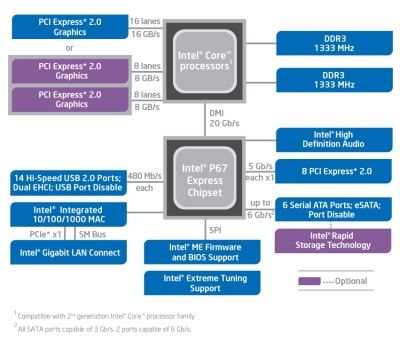 The layout of a P67 motherboard: you'll
The layout of a P67 motherboard: you'llneed one of these to overclock a Sandy Bridge CPU.
Click to enlarge.
This may not sound significant, but it means that overclocking via the Base Clock is extremely limited, if not impossible, as even sensitive buses such as SATA are linked to the ring bus clock.
In our testing, we found that increasing the Base Clock beyond 105MHz (from the default 100MHz) resulted in lock-ups and crashes no matter which other BIOS options we tried.
The Sandy Bridge Review: Intel Core i7-2600K, i5-2500K and Core i3-2100
ntel never quite reached 4GHz with the Pentium 4. Despite being on a dedicated quest for gigahertz the company stopped short and the best we ever got was 3.8GHz. Within a year the clock (no pun intended) was reset and we were all running Core 2 Duos at under 3GHz. With each subsequent generation Intel inched those clock speeds higher, but preferred to gain performance through efficiency rather than frequency.
Today, Intel quietly finishes what it started nearly a decade ago. When running a single threaded application, the Core i7-2600K will power gate three of its four cores and turbo the fourth core as high as 3.8GHz. Even with two cores active, the 32nm chip can run them both up to 3.7GHz. The only thing keeping us from 4GHz is a lack of competition to be honest. Relying on single-click motherboard auto-overclocking alone, the 2600K is easily at 4.4GHz. For those of you who want more, 4.6-4.8GHz is within reason. All on air, without any exotic cooling.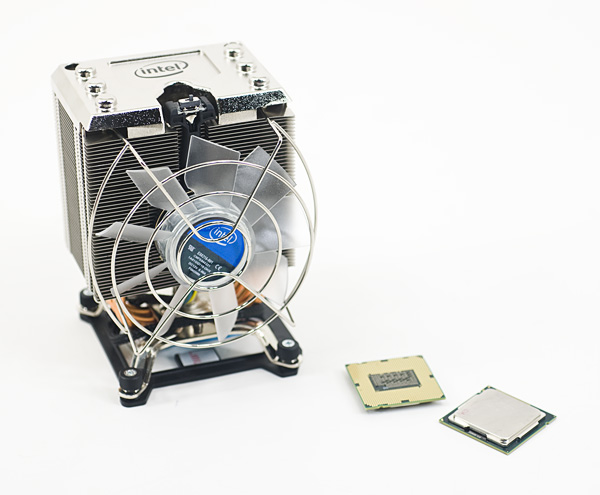
Unlike Lynnfield, Sandy Bridge isn’t just about turbo (although Sandy Bridge’s turbo modes are quite awesome). Architecturally it’s the biggest change we’ve seen since Conroe, although looking at a high level block diagram you wouldn’t be able to tell. Architecture width hasn’t changed, but internally SNB features a complete redesign of the Out of Order execution engine, a more efficient front end (courtesy of the decoded µop cache) and a very high bandwidth ring bus. The L3 cache is also lower and the memory controller is much faster. I’ve gone through the architectural improvements in detail here. The end result is better performance all around. For the same money as you would’ve spent last year, you can expect anywhere from 10-50% more performance in existing applications and games from Sandy Bridge.
I mentioned Lynnfield because the performance mainstream quad-core segment hasn’t seen an update from Intel since its introduction in 2009. Sandy Bridge is here to fix that. The architecture will be available, at least initially, in both dual and quad-core flavors for mobile and desktop (our full look at mobile Sandy Bridge is here). By the end of the year we’ll have a six core version as well for the high-end desktop market, not to mention countless Xeon branded SKUs for servers.
The quad-core desktop Sandy Bridge die clocks in at 995 million transistors. We’ll have to wait for Ivy Bridge to break a billion in the mainstream. Encompassed within that transistor count are 114 million transistors dedicated to what Intel now calls Processor Graphics. Internally it’s referred to as the Gen 6.0 Processor Graphics Controller or GT for short. This is a DX10 graphics core that shares little in common with its predecessor. Like the SNB CPU architecture, the GT core architecture has been revamped and optimized to increase IPC. As we mentioned in our Sandy Bridge Preview article, Intel’s new integrated graphics is enough to make $40-$50 discrete GPUs redundant. For the first time since the i740, Intel is taking 3D graphics performance seriously.
It’s not all about hardware either. Game testing and driver validation actually has real money behind it at Intel. We’ll see how this progresses over time, but graphics at Intel today very different than it has ever been.
Despite the heavy spending on an on-die GPU, the focus of Sandy Bridge is still improving CPU performance: each core requires 55 million transistors. A complete quad-core Sandy Bridge die measures 216mm2, only 2mm2 larger than the old Core 2 Quad 9000 series (but much, much faster).
As a concession to advancements in GPU computing rather than build SNB’s GPU into a general purpose compute monster Intel outfitted the chip with a small amount of fixed function hardware to enable hardware video transcoding. The marketing folks at Intel call this Quick Sync technology. And for the first time I’ll say that the marketing name doesn’t do the technology justice: Quick Sync puts all previous attempts at GPU accelerated video transcoding to shame. It’s that fast.
There’s also the overclocking controversy. Sandy Bridge is all about integration and thus the clock generator has been moved off of the motherboard and on to the chipset, where its frequency is almost completely locked. BCLK overclocking is dead. Thankfully for some of the chips we care about, Intel will offer fully unlocked versions for the enthusiast community. And these are likely the ones you’ll want to buy. Here’s a preview of what’s to come:
The lower end chips are fully locked. We had difficulty recommending most of the Clarkdale lineup and I wouldn’t be surprised if we have that same problem going forward at the very low-end of the SNB family. AMD will be free to compete for marketshare down there just as it is today.
With the CPU comes a new platform as well. In order to maintain its healthy profit margins Intel breaks backwards compatibility (and thus avoids validation) with existing LGA-1156 motherboards, Sandy Bridge requires a new LGA-1155 motherboard equipped with a 6-series chipset. You can re-use your old heatsinks however.
The new chipset brings 6Gbps SATA support (2 ports) but still no native USB 3.0. That’ll be a 2012 thing it seems.
Today, Intel quietly finishes what it started nearly a decade ago. When running a single threaded application, the Core i7-2600K will power gate three of its four cores and turbo the fourth core as high as 3.8GHz. Even with two cores active, the 32nm chip can run them both up to 3.7GHz. The only thing keeping us from 4GHz is a lack of competition to be honest. Relying on single-click motherboard auto-overclocking alone, the 2600K is easily at 4.4GHz. For those of you who want more, 4.6-4.8GHz is within reason. All on air, without any exotic cooling.

Unlike Lynnfield, Sandy Bridge isn’t just about turbo (although Sandy Bridge’s turbo modes are quite awesome). Architecturally it’s the biggest change we’ve seen since Conroe, although looking at a high level block diagram you wouldn’t be able to tell. Architecture width hasn’t changed, but internally SNB features a complete redesign of the Out of Order execution engine, a more efficient front end (courtesy of the decoded µop cache) and a very high bandwidth ring bus. The L3 cache is also lower and the memory controller is much faster. I’ve gone through the architectural improvements in detail here. The end result is better performance all around. For the same money as you would’ve spent last year, you can expect anywhere from 10-50% more performance in existing applications and games from Sandy Bridge.
I mentioned Lynnfield because the performance mainstream quad-core segment hasn’t seen an update from Intel since its introduction in 2009. Sandy Bridge is here to fix that. The architecture will be available, at least initially, in both dual and quad-core flavors for mobile and desktop (our full look at mobile Sandy Bridge is here). By the end of the year we’ll have a six core version as well for the high-end desktop market, not to mention countless Xeon branded SKUs for servers.
The quad-core desktop Sandy Bridge die clocks in at 995 million transistors. We’ll have to wait for Ivy Bridge to break a billion in the mainstream. Encompassed within that transistor count are 114 million transistors dedicated to what Intel now calls Processor Graphics. Internally it’s referred to as the Gen 6.0 Processor Graphics Controller or GT for short. This is a DX10 graphics core that shares little in common with its predecessor. Like the SNB CPU architecture, the GT core architecture has been revamped and optimized to increase IPC. As we mentioned in our Sandy Bridge Preview article, Intel’s new integrated graphics is enough to make $40-$50 discrete GPUs redundant. For the first time since the i740, Intel is taking 3D graphics performance seriously.
| CPU Specification Comparison | ||||||||
| CPU | Manufacturing Process | Cores | Transistor Count | Die Size | ||||
| AMD Thuban 6C | 45nm | 6 | 904M | 346mm2 | ||||
| AMD Deneb 4C | 45nm | 4 | 758M | 258mm2 | ||||
| Intel Gulftown 6C | 32nm | 6 | 1.17B | 240mm2 | ||||
| Intel Nehalem/Bloomfield 4C | 45nm | 4 | 731M | 263mm2 | ||||
| Intel Sandy Bridge 4C | 32nm | 4 | 995M | 216mm2 | ||||
| Intel Lynnfield 4C | 45nm | 4 | 774M | 296mm2 | ||||
| Intel Clarkdale 2C | 32nm | 2 | 384M | 81mm2 | ||||
| Intel Sandy Bridge 2C (GT1) | 32nm | 2 | 504M | 131mm2 | ||||
| Intel Sandy Bridge 2C (GT2) | 32nm | 2 | 624M | 149mm2 | ||||
Despite the heavy spending on an on-die GPU, the focus of Sandy Bridge is still improving CPU performance: each core requires 55 million transistors. A complete quad-core Sandy Bridge die measures 216mm2, only 2mm2 larger than the old Core 2 Quad 9000 series (but much, much faster).
As a concession to advancements in GPU computing rather than build SNB’s GPU into a general purpose compute monster Intel outfitted the chip with a small amount of fixed function hardware to enable hardware video transcoding. The marketing folks at Intel call this Quick Sync technology. And for the first time I’ll say that the marketing name doesn’t do the technology justice: Quick Sync puts all previous attempts at GPU accelerated video transcoding to shame. It’s that fast.
There’s also the overclocking controversy. Sandy Bridge is all about integration and thus the clock generator has been moved off of the motherboard and on to the chipset, where its frequency is almost completely locked. BCLK overclocking is dead. Thankfully for some of the chips we care about, Intel will offer fully unlocked versions for the enthusiast community. And these are likely the ones you’ll want to buy. Here’s a preview of what’s to come:
The lower end chips are fully locked. We had difficulty recommending most of the Clarkdale lineup and I wouldn’t be surprised if we have that same problem going forward at the very low-end of the SNB family. AMD will be free to compete for marketshare down there just as it is today.
With the CPU comes a new platform as well. In order to maintain its healthy profit margins Intel breaks backwards compatibility (and thus avoids validation) with existing LGA-1156 motherboards, Sandy Bridge requires a new LGA-1155 motherboard equipped with a 6-series chipset. You can re-use your old heatsinks however.
The new chipset brings 6Gbps SATA support (2 ports) but still no native USB 3.0. That’ll be a 2012 thing it seems.
Monday, June 6, 2011
10 Tips Buying VGA Card
10 Tips Buying VGA Card
If we see, the development VGA graphics card or the current was so fast. Several new variants are always popping up from both ATI and Nvidia camps along with the latest teknologi2 adopted by their latest VGA. For a layman who wants to buy the VGA must be confused with VGA varian2 number offered by the various graphics card manufacturers.1. Do not be tempted amount of memory
Buying a Radeon X1300 VGA-type card with 512Mb of memory ability is not as good when compared with type Radeon X1600 with 256Mb memory. Why? Because determining the strength is as a feature VGA Card GPU support. From some testing, VGA cards, Memory 512Mb only 256Mb jack up 10% dr
2. Graphics Processing Unit (GPU)
When it is hot ni VGA battle between two vendors of the ATI Radeon and NVIDIA DEFORCE. Each "product is divided into three categories namely VGA low-end, mid-end, high end. As a price comparison for VGA "low-end types can be bought with a price below a mid-end jt jt 1-2, to high-end 2 jt s dr / d 8jt. High-End Type clearly a best class yet high enough in terms of price, besides many such variants jg GT, GS, GTX, XT, and XTX who is the highest, usually distinguishing these variants of the shader level, clock speed and number of pipeline owned.
3. Clock Speed VS Pipeline
No user contemporaries saw lg dr Clock ratenya VGA only. Jg user should note is that the number of existing pipeline intramural every graphics card. Beneficial to see if the user feels a new pipeline to buy middle clas VGA & upwards. Typically middle-class graphics cards have been buried 8 to 12 pipelines. Create a class who are usually embedded flat "16 pipelines. Eminence clock speed certainly a plus tp jd if gamers want to spend some time before buying & compare between clock speed and pipeline, the user will be more fortunate. Remember this "It's better to have eight pipeline with a clock speed of 400MHz, instead of four pipelines with a 500MHz clock speed."
4. Vista & Direct3D 10
Vista includes DirectX 10, the version of Direct X. The most Anyar Direct X 10 is not alone, because the plan would be in one after another with the release of the latest version of 3D direct dr. DirectX 10 will eventually divide the functions of CPU and GPU which is more heavy workload placed on the GPU
5. Wait timeliness
NVidia & ATI jd enemies who will never stop competing. The advantage almost every 12-18 months 1x users will find the graphics card with chip "latest. Each release of the product, the graphics card vendors will include a variety of new features such as high definition video and increasing clockspeed. Make sure the user really "sure about the graphics card users who buy. Do not let the user regret, because the receipts issued is not small. If not too concerned with new products just find the old type of graphics card with a maximum work. Usually the price is quite oblique, let alone VGA coupled with the release of new models, old graphics card would drop the price.
6. No need to 5 million
GeForce 7900 GT is a graphics card Hight-end class with a price <3Jt. The most recent graphics card users who can search on a certain price ditoko 5Jt. if gamers looking for performance-price 2-3Jt, bsa users get quality graphics card. Honey money 5Jt if only used for VGA only. Users can compare the price of old & new type VGA. If indeed the price difference is not too far select the new course. But if too much why not just choose the cheap?
7. Note the Power Supply
Power Supply is the most important factor computing devices, dr. I used Power Supply is no third choice when buying a PC user. But now, because of new hardware being hectic require huge resources. For class graphics cards are usually equipped with low-end 300-350watt power supply. But mid & high clas VGA requires a minimum of 400-450 watts. Type of VGA card ATI Radeon X1900XTX Crossfire even need a minimum 550 watt power supply.
8. Select AGP or PCI Express?
PCI Express is a best choice. PCI has replaced AGP as the VGA slot who have been long enough.
9. SLI and Crossfire
Who have a more special budget can get a VGA card with 4 GPU at the same time by buying a GeForce 7950 GX2 dual-card graphics card's tough in terms of price, but satisfied in terms of quality. Mother Board Notice of GS to be consistent.
With dual-card graphics cards who want to buy there second choice is Nvidia's SLI or ATI Crossfire dr. Both graphics card vendors usually have to include the appropriate brand motherboard with a graphics card made out of the release. If confused just clay are normally written from the spec motherboard with CrossFire or SLI support or tdak. The price varied depending on the existing features on the motherboard
10. Budget mediocre with onboard VGA?
The limited budget sometimes there is no other choice. VGA onboard who have had limited ability plihan jd. To work on Word and graphics applications are quite simple. But playing games on the middle class do not expect to be comfortable. Essentially gamers should buy a new VGA Add ON with good specifications.
Material Considerations
High resolution monitor?
If your monitor's resolution is only 1024 × 768 pixels, a bit useless to buy a top-class graphics card. middle-class graphics cards such as Radeon HD2600 or GeForce 8600 to be sufficient
DirectX 9 or 10?
Though DirectX 10 based games are still rare, there is no harm in you from now on choosing a graphics card that supports DirectX 10.
It took a bundle game?
Often the price of a graphics card because of too many bundles or completeness of the included games. In fact, you may not need it. So, carefully before buying.
Tips For Choose VGA
The first factor that must be considered to select the Add-on VGA is appropriate is the type of slots, of course we should choose the same slot with slot on the motherboard. There are two types of slots for VGA, the AGP and PCI-Express (PCI-E). Types of AGP slots are very rarely found on the latest motherboards. This species is widely used by the motherboards which is a bit “old”. Today, most motherboard uses PCI-E.
Another factor is the characteristics of his or VGA specification. three things which we need to consider the specifications of the VGA is the memory capacity, memory type and width of the lines of communication “buswidth”. For example there is a VGA with 256 MB DDR3 specification of 128 bits. 256 MB VGA memory size means they will be, is influenced more by the high-resolution VGA which can be supported by it. If want to use a large size monitor (which, of course, the resolution is too high) then the VGA memory capacity must also be greater. DDR3 is a type of memory which refers to the speed of access. DDR3 course is relatively fast access to legal aid when compared to DDR2. 128 bits is the width of the track, the width of the track, the more data can reply through at one time. Proverbial equal gate toll road, the more cars the more gates can reply through, the shorter the line, the sooner arrived at the destination.
 Of course we should not forget other factors, such as its own type of GPU. Just as the processor, the GPU also has the speed (core clock) which is measured with units of MHz. In fact, exactly like the processor, even now already is the GPU which has more than 1 core. We will discuss non-technical unduly about this GPU. In essence a new generation GPU more distinguished performance is also better than older generations (of origin the memory comparable specifications).
Of course we should not forget other factors, such as its own type of GPU. Just as the processor, the GPU also has the speed (core clock) which is measured with units of MHz. In fact, exactly like the processor, even now already is the GPU which has more than 1 core. We will discuss non-technical unduly about this GPU. In essence a new generation GPU more distinguished performance is also better than older generations (of origin the memory comparable specifications).
In addition, another factor which also must be considered is the output port. There is still a D-Sub (reply port commonly used in CRT monitors), there is a DVI (usually for some type of LCD monitors) and even some HDMI (for High Definition LCD monitor). Often, too, there are S-Video port, namely port round to be connected with a TV set which functioned as a monitor. In some types of VGA, or even the already supports more than 1 monitor.
Another factor is the characteristics of his or VGA specification. three things which we need to consider the specifications of the VGA is the memory capacity, memory type and width of the lines of communication “buswidth”. For example there is a VGA with 256 MB DDR3 specification of 128 bits. 256 MB VGA memory size means they will be, is influenced more by the high-resolution VGA which can be supported by it. If want to use a large size monitor (which, of course, the resolution is too high) then the VGA memory capacity must also be greater. DDR3 is a type of memory which refers to the speed of access. DDR3 course is relatively fast access to legal aid when compared to DDR2. 128 bits is the width of the track, the width of the track, the more data can reply through at one time. Proverbial equal gate toll road, the more cars the more gates can reply through, the shorter the line, the sooner arrived at the destination.

In addition, another factor which also must be considered is the output port. There is still a D-Sub (reply port commonly used in CRT monitors), there is a DVI (usually for some type of LCD monitors) and even some HDMI (for High Definition LCD monitor). Often, too, there are S-Video port, namely port round to be connected with a TV set which functioned as a monitor. In some types of VGA, or even the already supports more than 1 monitor.
Tuesday, May 24, 2011
SSD(Solid State Drive)
A solid state disk / drive (SSD) - is electrically, mechanically and software compatible with a conventional (magnetic) hard disk.
The difference is that the storage medium is not magnetic (like a hard disk) or optical (like a CD) but solid state semiconductor such as battery backed RAM, RRAM, PRAM or other electrically erasable RAMlike non volatile memory chip such as flash.
This provides faster access time than a hard disk, because the SSD data can be randomly accessed in the same time whatever the storage location. The SSD access time does not depend on a read/write interface head synchronising with a data sector on a rotating disk. The SSD also provides greater physical resilience to physical vibration, shock and extreme temperature fluctuations. SSDs are also imune to strong magnetic fields which could sanitize a hard drive.
The only downside to SSDs is a higher cost per megabyte of storage - although in some applications the higher reliability of SSDs makes them cheaper to own than replacing multiple failing hard disks. When the storage capacity needed by the application is small (as in some embedded systems) the SSD can actually be cheaper to buy because hard disk oems no longer make low capacity drives. Also in enterprise server acceleration applications - the benefit of the SSD is that it reduces the number of servers needed compared to using hard disk based RAID on its own.
Historically RAM based SSDs were faster than flash based products - but in recent years the performance of the fastest flash SSDs has been more than fast enough to replace RAM based systems in many server acceleration applications.
Both types of SSDs are available in a wide range of form factors and supporting traditional disk interfaces. A complete list of manufacturers with tables by form factor, technology type and interface type is updated in real-time in the Solid State Disks Buyers Guide
The reasons that users might benefit from buying SSDs are listed in the SSD Market Adoption Model
Take the case of SSD speedup in servers. One way of thinking about this concept in computer architecture is - SSD CPU Equivalency. For a wide range of applications if you take a black box approach and analyze the overall application performance of a computer system - you would not know whether that system had more CPUs with hard disks or less CPUs with more SSDs.
Implicit in all my usages of the term "flash SSD" is the assumption that the device includes some form of controller which performs wear-leveling - as opposed to less smart flash memory storage which doesn't.
Why Use a Solid State Drive?
Solid state drives have several advantages over the magnetic hard drives. The majority of this comes from the fact that the drive does not have any moving parts. While a traditional drive has drive motors to spin up the magnetic platters and the drive heads, all the storage on a solid state drive is handled by flash memory chips. This provides three distinct advantages:
The difference is that the storage medium is not magnetic (like a hard disk) or optical (like a CD) but solid state semiconductor such as battery backed RAM, RRAM, PRAM or other electrically erasable RAMlike non volatile memory chip such as flash.
This provides faster access time than a hard disk, because the SSD data can be randomly accessed in the same time whatever the storage location. The SSD access time does not depend on a read/write interface head synchronising with a data sector on a rotating disk. The SSD also provides greater physical resilience to physical vibration, shock and extreme temperature fluctuations. SSDs are also imune to strong magnetic fields which could sanitize a hard drive.
The only downside to SSDs is a higher cost per megabyte of storage - although in some applications the higher reliability of SSDs makes them cheaper to own than replacing multiple failing hard disks. When the storage capacity needed by the application is small (as in some embedded systems) the SSD can actually be cheaper to buy because hard disk oems no longer make low capacity drives. Also in enterprise server acceleration applications - the benefit of the SSD is that it reduces the number of servers needed compared to using hard disk based RAID on its own.
Historically RAM based SSDs were faster than flash based products - but in recent years the performance of the fastest flash SSDs has been more than fast enough to replace RAM based systems in many server acceleration applications.
Both types of SSDs are available in a wide range of form factors and supporting traditional disk interfaces. A complete list of manufacturers with tables by form factor, technology type and interface type is updated in real-time in the Solid State Disks Buyers Guide
The reasons that users might benefit from buying SSDs are listed in the SSD Market Adoption Model
Take the case of SSD speedup in servers. One way of thinking about this concept in computer architecture is - SSD CPU Equivalency. For a wide range of applications if you take a black box approach and analyze the overall application performance of a computer system - you would not know whether that system had more CPUs with hard disks or less CPUs with more SSDs.
Implicit in all my usages of the term "flash SSD" is the assumption that the device includes some form of controller which performs wear-leveling - as opposed to less smart flash memory storage which doesn't.
Why Use a Solid State Drive?
Solid state drives have several advantages over the magnetic hard drives. The majority of this comes from the fact that the drive does not have any moving parts. While a traditional drive has drive motors to spin up the magnetic platters and the drive heads, all the storage on a solid state drive is handled by flash memory chips. This provides three distinct advantages:
- Less Power Usage
- Faster Data Access
- Higher Reliability
Subscribe to:
Comments (Atom)
Standard Component
Processor
RAM
MainBoard
